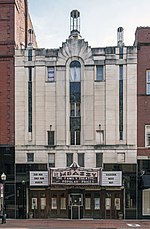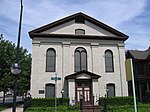Canal Place
Buildings and structures in Cumberland, MarylandCanal museums in the United StatesChesapeake and Ohio CanalDowntown Cumberland, MarylandMuseums in Allegany County, Maryland ... and 4 more
National Park Service areas in MarylandParks in Allegany County, MarylandParks in Cumberland, MD-WV-PATransportation museums in Maryland

Canal Place is a 58.1-acre (235,000 m2) heritage area located in Cumberland, Maryland at the western terminus of the Chesapeake and Ohio Canal.
Excerpt from the Wikipedia article Canal Place (License: CC BY-SA 3.0, Authors, Images).Canal Place
Canal Street, Cumberland
Geographical coordinates (GPS) Address Website Nearby Places Show on map
Geographical coordinates (GPS)
| Latitude | Longitude |
|---|---|
| N 39.649393 ° | E -78.763411 ° |
Address
Western Maryland Railway Station
Canal Street 13
21502 Cumberland
Maryland, United States
Open on Google Maps










